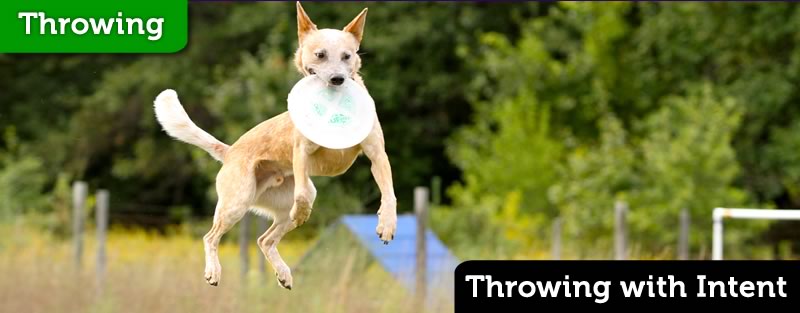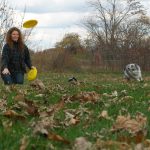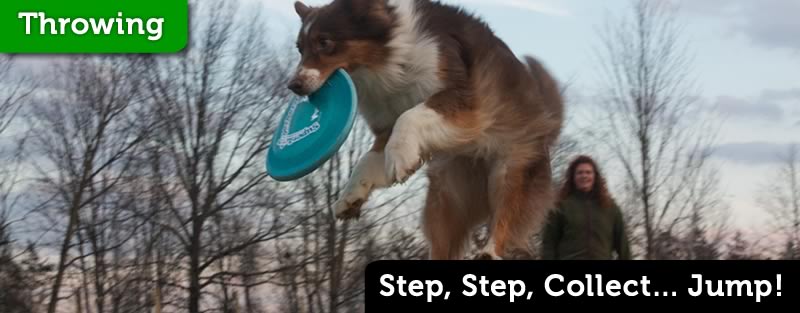Leaping for Discs with the High Drive Dog
http://www.facebook.com/OlympicDiscDogs
Cassi Anderson
Ok Ron. Your next task I know you work a lot a core exercises as well, give us some ideas on jumping techs and body awareness!
Sounds good Cassie! Let’s do it.
In that facebook thread you mentioned your dog hitting your body and your dog is a “very fast very high drive dog, who trips over his own feet!”
Odds are that he’s just really into the disc. Get there at all costs – NOW! There are many dogs like this. As soon as the disc is released, the dog pursues it directly no thinking, just aggressive reaction. Dogs that love to bite, dogs that love to jump and dogs that love the chase can be too aggressive in their pursuit and be in poor shape for a leap. They take off at a head down gallop, run as hard and as fast as caninely possible, then cannot collect to change their trajectory for a decent leap.
Dogs with ‘premature ejumpulation‘, dogs that have a history of overrunning/under-jumping discs, and dogs that leap crazily dragging their rears all can benefit from simple disc placement exercises.
Throw it Higher!
“What? He already jumps 5 feet in the air! Are you crazy?”
Not at all. What I’m talking about is throwing it REALLY high, 15-20+ feet in the air, throw it way up there and let it float down as it runs away from you. This will make the super high drive dog raise their head and lower their rear in order to follow, or track, the disc. Think of creating a permanent collection or a moving collection, that raised head and dropped rear combined with the slow linear speed of the disc floating down will slow down the high drive dog and get them out of that head down gallop habit.
Throwing low ‘to keep my dog safe’ is a very common problem for many handlers with dogs that are aggressive. The low disc makes the aggressive dog run harder, head down further, and enables them to be successful with that technique. The dog learns that Disc is about running as hard as I can and grabbing that disc on the run. Leaping is not even possible, let alone in the picture or on the dog’s mind.
Throw it higher and make your dog slow down and to get their head up.
Throw it Shorter!
Now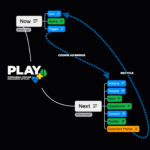 The Now Phase is an integral part of the Play Cycle in the Play+ training philosophy. It embodies the current, immediate interaction between the handler and the dog, anchoring them in the present... More that your dog is looking up at the target and moving a bit slower, try throwing the disc shorter, like 7 yards – max. Set that disc up there quickly so the dog never has the opportunity to hit that head down gallop. Set your disc at your dog’s leaping height about 3 of your dog’s strides away from you. You and your dog will develop a rhythm: Step, step, step… collect, Jump! bum, bum, bum, budum, bum…
The Now Phase is an integral part of the Play Cycle in the Play+ training philosophy. It embodies the current, immediate interaction between the handler and the dog, anchoring them in the present... More that your dog is looking up at the target and moving a bit slower, try throwing the disc shorter, like 7 yards – max. Set that disc up there quickly so the dog never has the opportunity to hit that head down gallop. Set your disc at your dog’s leaping height about 3 of your dog’s strides away from you. You and your dog will develop a rhythm: Step, step, step… collect, Jump! bum, bum, bum, budum, bum…
Work that rhythm with consistent placement and you should notice a dramatic difference in your dog’s leaping ability.
Pattern Train
After you slow the dog down and set the pattern of step, step, step… collect, Jump! Make that pattern a habit. Over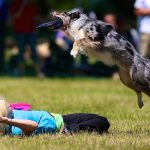 An Over is any leaping catch that happens over top of the handler’s body. Overs are usually named by the part of the body over which the dog flies, i.e - Leg Over,... More and over again. Step, step, step… collect, Jump! Here at Pawsitive Vybe, we warm up with 3-5 of these tosses. We also drop them into Zig Zags, in our Zig Zag
An Over is any leaping catch that happens over top of the handler’s body. Overs are usually named by the part of the body over which the dog flies, i.e - Leg Over,... More and over again. Step, step, step… collect, Jump! Here at Pawsitive Vybe, we warm up with 3-5 of these tosses. We also drop them into Zig Zags, in our Zig Zag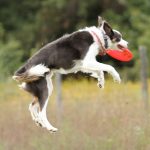 A Zig Zag is a series of catches in smooth succession that forces the dog to move back and forth across the field. Usually performed at a distance of 8-20 yards, the Zig... More for Big Leaping drill.
A Zig Zag is a series of catches in smooth succession that forces the dog to move back and forth across the field. Usually performed at a distance of 8-20 yards, the Zig... More for Big Leaping drill.
Once the dog has gotten into the habit of running 7-8 yards after a disc – step, step, step… collect, Jump! what do you think happens when the disc is out at 40 yards?
When the dog gets to 32 yards, 7-8 yards away from the disc?
He goes: step, step, step… collect, Jump! and kills it.







